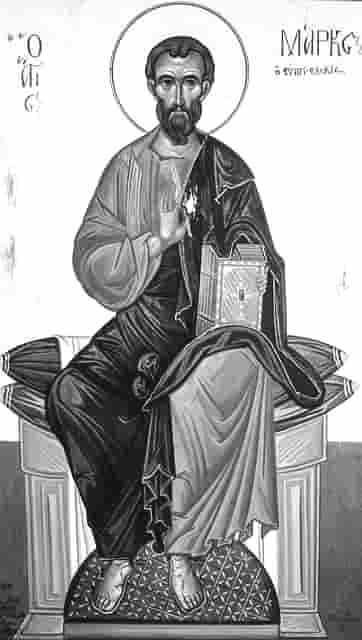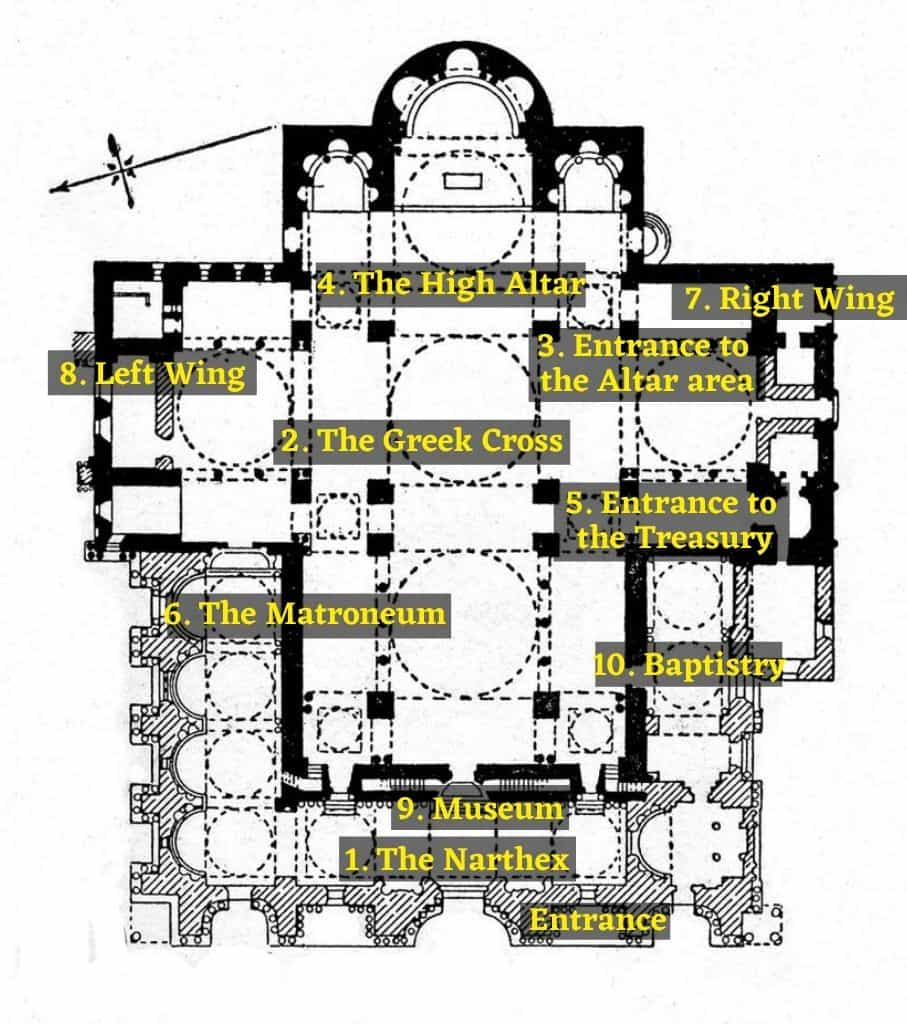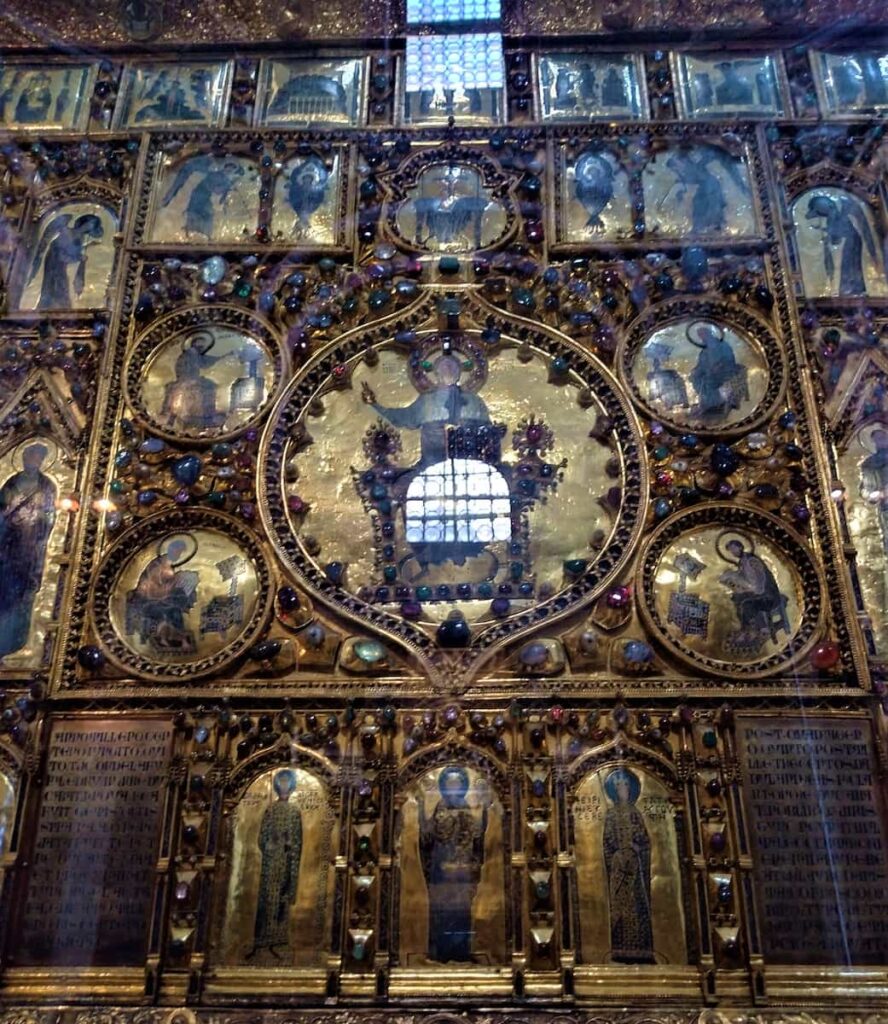
The Saint Mark’s Basilica is the main church in Venice. It was first constructed as the Doge’s private chapel and didn’t become the seat of the Patriarch until 1807, after the fall of the Republic. The first building was from 828, but it was then modified, enlarged, decorated, and rebuilt after the many fires during the centuries. What you see today is mostly from the 15th century.
The Practical Stuff
St Mark’s Basilica – Opening hours.
The Basilica is situated on the eastern side of Saint Mark’s Square. The entrance is on the right-hand side of the facade.
Weekdays: 9.30 a.m. – 5.00 p.m. (entrance free – last admission 4.45 p.m.) –
Sunday and holidays: 2.00 p.m. – 5.00 p.m. (last admission 4.45 p.m; last admission “skip the line” 4.30 p.m.)
From April 16 – October 28 Sunday and Holidays, 2.00 p.m. – 4.30 p.m. (last admission 4.15 p.m; last admission “skip the line” 4.00 p.m.)
St. Mark’s Museum: Entrance: ticket 5 €, children half price.
The altar, Pala d’Oro: Entrance: ticket 2 €, children half price.
Treasury: Entrance: ticket 3 €, children half price.
Bags and backpacks.
You can’t bring bags inside the Basilica. You have to deposit them, free of charge, in Ateneo San Basso (Piazzetta dei Leoncini – in front of the Gate of Flowers, north façade).
Photography in St Mark’s Basilica.
It’s strictly forbidden to use cameras or video recorders inside the Basilica.
Dress-code.
Covered legs and covered shoulders.
Men: No shorts, half-leg should be as long as below the knee. No tank-top. T-shirt is Ok.
Women: The skirt should cover the knee. Shoulders should be covered. The neckline should be reasonably high.
Waiting in lines outside
In winter it’s not a big problem to get in. In November, December, January, and March there are normally not very long lines. In summer you should definitely consider the skip-the-line ticket. It’s 3 euro but you avoid standing out in the sun, waiting.
St Mark’s Basilica – Guided tours.
There are many tour companies offering guided tours, but the Procuratory has a free guide service. Check the link for any variations in the timetable. The tour is suspended as of spring 2022.
Just show up at 11 am. and you can hop along. Italian, English (All days except Saturdays and Sundays), German (Friday), French (Monday, Wednesday, and Friday), and Spanish (Friday). The meeting point is in the Narthex, before entering or after leaving.
The origins of the Venice cathedral.
The first St Mark’s Basilica was built in 828 when the relics of the Saint first came to Venice from Alexandria in Egypt. It was built slightly further north of the present church. On the site, there was one, or possibly two, older chapels. Already in 832, that building was replaced by another one on the present site.

After the rebellion and fires in 976, the Doge Pietro I Orseolo built a new church to St Mark. This one stood ready only two years after. In the second half of the 11th century, there was yet another reconstruction. This time the St Mark’s Basilica was consecrated in 1094, and it now had a definite resemblance to the Basilica of the Holy Apostles of Constantinople. Although work continued for many centuries, this was the Cathedral we see today.
In 1231 there was another fire, but the church was rebuilt immediately.
By the first half of the 13th century, a vestibule was built (the narthex), creating the conditions for the construction of a facade. Before then the exterior was with exposed bricks
St Mark’s basilica
At the end of the 12th century, the whole square was extended. At this point, the domes were raised with Byzantine and Fatimid construction techniques, and the attic under the outer lead sheathed domes was built. The facade was created with building materials from Constantinople. When the decoration of the upper part of the facade was completed in the 15th century, the current external appearance of the basilica was finished.
The Baptistery, the Sacristy, and the Zen Chapel were built in the 14- and 1500. And with the current arrangement of two altars, the basilica can be said to have been completed.
In all this time the Basilica still wasn’t the official Cathedral of Venice, but the chapel of the Doge. The main church in Venice was from the beginning, the Basilica di San Pietro di Castello. Here the Patriarchy was moved already in the 8th century from Grado. Only after the end of the Republic in 1807, the Basilica di San Marco became the home of the Patriarch.
The Facade.
Before entering, take a minute to admire the facade of the building. It’s a masterpiece, rich and full of decorations and mosaic images. The impressive five doors with the double vaults over each one. The mosaics here are from the 13th century but the only one still original is the one to the left, the portal of Sant’Alipio. This is where Saint Mark entered the Basilica in 828, according to tradition.
Now he’s standing (the statue) on top of the central portal with a winged lion underneath. Further down there are the four Byzantine horses (copies, the real ones are inside in the museum.) and the balcony along the full width of the wall.
The Basilica in Venice – A golden shrine.

If you’ve visited other Italian churches and cathedrals from the middle ages, you will immediately find this one very different. First, it’s kind of low. This has to do with the particularity of Venice. It’s difficult to build vertically because the ground can’t resist the weight.
Then it’s very dark… And it’s very golden. The atmosphere is like walking into a chamber or a palace of pure gold. In fact, there are more than 8000 square meters of mosaics inside and the major part of them is made of gold. It’s all yellow.
If you look up, at the domes, you see the small windows. They let only a fraction of the intense sunlight outside, come in and chase some of the shadows away. But the colors remain very dark. And that brings us to the origins because this is a Byzantine Basilica (even though the Christian patriarchy insists that it’s not really) and the oriental feel is very present. Imagine a room in the Sultan’s Palace with few or no openings to keep the hot desert sun out and prevent it from warming the cool air inside.
The length is 76,5 meters and it’s 62,6 meters wide at the widest. The highest point, the central dome is 43 meters but inside it’s only 28. That’s because on top of the outer domes there are the oriental onions and crosses reaching at least 7 or 8 meters above the dome top. Between the inner and outer roof, there’s an attic covering the whole structure.
Now let’s take a look around:

The Narthex.
Before you enter the Basilica you pass the Narthex. Here, if you look up, there are several smaller domes. The motifs are Genesis and episodes of the lives of Noah, Abraham, Joseph, and Moses. Currently, the narthex consists of two rooms, as the Baptistery and Zen Chapel were obtained by closing the south side. The mosaics mark the time of waiting for the coming of Jesus, following the thread that identifies the phases of the history of salvation.
In the dome of Abraham, the protagonist is depicted four times in conversation with God, represented by a hand that comes out of a slice of heaven.
In the dome of Genesis or the Creation, there are twenty-six scenes that begin with the creation of heaven and earth. Uncommon is the scene of the blessing of the seventh day “with God on the throne surrounded by the six angels of the first six days.
The mosaics were created between 1220 and 1270.
The interior – the Greek cross.
The plan of the basilica is a Greek cross with five domes distributed in the center and along the axes of the cross and connected by arches (as with the church of the Holy Apostles in Constantinople that was an evident model for the Venetian basilica). There are three aisles on each arm.

The domes represent from the entrance: The Pentecost, the Ascension over the central part, and the dome of Emanuel over the altar. But before the domes, right over the entrance, there’s the arc of the apocalypse.
Walls and pillars throughout the main hall are completely covered with polychrome marble slabs. The floor has a marble coating designed with geometric modules and animal figures using Greek and Roman mosaic techniques. Some original parts are from the XII century. The floor reflects motifs of classical iconography, common in the upper Adriatic area (wheels, squares, hexagons, octagons, frames decorated with rhombuses, and images of symbolic animals). There are also clear Byzantine influences (the eight large slabs in Proconnesian marble and twelve more of Greek marble under the Ascension dome).
The great mosaic floor on the central part is called the sea by the Venetians. The reasons are the wave-formed shape and color of the figures but more so for the irregularity caused by the ground settlements. It’s wavy.
Entrance to the Altar-area and the Pala d’Oro.

Entrance fee 2 euro
The High altar.
The location of the altar, is not in the center of the interior, as in Byzantine churches, but at the far end according to roman catholic tradition. And the arms of the Greek cross are not identical, but on the east-west axis, they have the widest central nave. This is to promote the gaze towards the main altar, from every part of the room.

Between the Presbyter and the main hall, there is an Iconostasis. This separates the clergy from the worshippers. On it stand the 12 apostles together with the virgin Mary and Saint Mark.
On the backside of the main Altar is the priceless work of art; “La Pala d’oro“. the golden altarpiece. It’s a large antependium in gold, silver, enamels, and precious stones (212×334 cm), and it’s among the most relevant of its kind in the world. It was produced specifically for the basilica in the 10th century and enriched until the 14th.
To the right of the dome, you can see a mosaic showing the story of the two merchants Buono da Malamocco and Rustico da Torcello. They stole the bones of the Saint from Alexandria in Egypt and covered them in pig meat, to be able to get through the Islamic customs and coast guards.
Underneath the altar lies the remains of Saint Mark.
Entrance to the Treasury
Entrance fee 3 euro
The treasury of Saint Mark’s Basilica holds 283 valuable objects in gold and jewelry. A big part of the collection is loot from the sacking of Constantinople in 1204. It’s divided into four sections:
- Roman and middle age
- Byzantine
- Arab
- Venetian and western European
Interestingly, a part of the collection was used in 1797, to pay the French for their occupation of Venice (… And if they hadn’t paid? They wouldn’t have been invaded?).
The Matroneum
Along the sides of the Nave, there are overhead balconies, called Matroneum. These were dedicated to women worshippers.
The right wing.
Over your head, you have the Dome of the Venetian Saints / Saint Leonardo. You see three more Saints, San Nicola (south), San Clemente (west), and San Biagio (north). These are all significant to the history of Venice.
In the southern wall, there’s a door that connects this part to the Doge’s Palace. Immediately to your left, there’s the pulpit from where the newly elected Doge presented himself for the Venetians. Further ahead, to your left, there’s the chapel of San Clemente and the altar of the Sacrament. Here, in a pillar, the remains of San Marco were found in 1094. (They had been hidden away from rebellions, thefts, and misplacements during works and then forgotten… ).
The left wing.
The last dome is that of St. John the Evangelist.
Going in, the pulpit to your right is the one used for the religious services. Following it is the chappel of Saint Peter and the chappel of the Virgin Nocipeia, a Byzantine Icon, stolen from Constantinople after the fourth crusade.
Entrance to the museum.
Entrance fee 5 euro
You gain access to the museum from the Narthex before entering the Basilica.

It is divided into three sections, Mosaics, Textiles, and other Antiquities. Here you can see many pieces of interest from Venetian history, but the major attraction is obviously the Byzantine horses as well as the balcony from which you can admire the Square.
The horses, probably from the 3rd century, were placed at the starting point for the races at the big hippodrome of Constantinople. They came to Venice after the sacking of the Byzantine city in 1204. When Napoleon conquered Venice in 1797, he sent the horses to Paris. They were brought back to Venice by the Austrians in 1815 after Napoleon had been defeated at the battle of Waterloo.
The Crypt.
Underneath the presbytery, there’s a crypt. It’s not open to the public but you can get in on special guided tours on rare occasions. It’s accessible from two small doors that are not always noticeable to the left and to the right of the presbytery. The interior of the crypt holds a naked but remarkably ancient atmosphere.
In 1063 the Doge Domenico Contarini commissioned the construction of a new basilica to preserve the remains of the Evangelist Mark. The remains of the previous buildings were transformed into a crypt and the new basilica was built on top of it. Then when, in 1094, the body of Saint Mark was found inside a pillar in the chapel of San Clemente in the Basilica, it was placed with all honors inside the crypt.

But Venice has and has always had her problems with the water. And as the sea level rose, in 1563 it was deemed necessary to raise the floor of the crypt. But not even that resolved the problem and in 1604 the access to the crypt had to be closed and sealed.
Saint Mark’s basilica
In the following centuries, the crypt of San Marco was considered an insane and fetid place And even though the relics of the holy body of Mark were still there, nobody went down there apart from periodic controls and checking on the wall structures of the foundation.
(On the 12th of November 2019, Venice suffered its 2nd highest tide ever. The defense systems in Saint Mark’s Basilica were insufficient and water reached the floor inside the main hall. In the crypt, there were 1,20 meters of water. Fortunately, the staff acted promptly but they say that a disaster was only centimeters away. The water could in a worst-case scenario damage the whole foundation of the structure.) (We now put all our hopes into the new MOSE project, and foresee a dry Basilica in the near future.)
When restorations finally started in 1811 the wooden chest where the relics of the Evangelist were kept, was moved to a place under the main altar inside the church. The crypt was then reopened in 1889; since then it has also been used as a burial place for the Patriarchs of Venice.
Today the crypt is open to the public only two days a week, booked in advance.
The Baptistery.
In the southwest corner, there’s the Baptistery. This was once open to the south and was a part of the Atrium. In the first half of the 14th century, it was closed off, and a small chapel was created.
Sheltered from the confusion of visitors who flock to St. Mark’s Basilica in Venice every day is the baptistery, a fascinating place full of hidden treasures.
Inside there’s the tomb of Doge Andrea Dandolo with reliefs representing the Martyrdom of Saint Andrew and Saint John the Evangelist. At the center of the room stands the baptismal font in marble and bronze by Jacopo Sansovino,
The altar consists of a large boulder of red granite, brought here from Tire in 1126 and from which, according to tradition, Christ would have spoken to the crowds.
As with the Crypt, the Baptistery can only be visited with a guide, booked in advance.